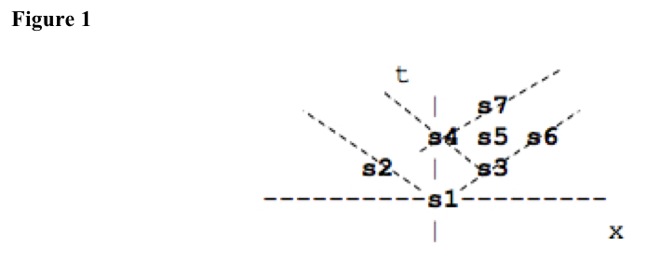

Simultaneity requires an observer and two space-time events. By direct observation, two space-time events are simultaneous {simultaneity, relativity}| if light signals from both events reach observer at same time. See Figure 1. To another observer at a different space-time event, the two events are not simultaneous. (If an observer sees that two events happen at the same spatial location, relatively moving observers do not calculate that they coincide.)
synchronized clocks
Two space-time events can be simultaneous for an observer if they occur at the same time on observer's synchronized clocks. Because this simultaneity occurs at distant space-time events, observer can only measure and calculate this simultaneity.
Observer reference-frame space coordinates show all space locations, with clocks synchronized to same time. Events that happen on a space-time space coordinate are all at the same time. For example, at space-time origin, time is 0, and space coordinate shows all space locations, whose events have time 0.
space coordinates
Space coordinates for relatively moving observers are different. Compared to stationary observers, uniformly moving observers move toward stationary-observer synchronized clocks, and receive light rays sooner than stationary observers. Because they come sooner, relatively moving observers calculate that those light rays came from later-time events. See Figure 1.
examples
At s1, observer has time 0 and position 0. s2 and s3 happen at same time on time axis, and information about them reaches s4 at same time.
Information from s1 reaches s2 and s3 at same time on time axis, so they are simultaneous. s2 and s3 are two different observers.
Because signals travel at light speed, information from s1 can reach s6.
Information from s1 cannot reach s4, s5 or s7.
Information from s3 reaches s6 later.
At s4, observer is at time 2 and position 0. Information from s4 reaches s7.
s4, s5, and s6 happen at same time on time axis.
No information about s1, s2, s3, s4, and s6 reaches s5.
Information about s3 reaches s6.
Information about s5 comes to observer at position 0 sooner than information from s6, because s5 is closer in space.
s7 happens later than s4, s5, and s6 on time axis.
space-time separation
Observers and objects move through space-time events. Space-time events have space-time separations. In space-time, neither time separation nor space separation exists independently.
Simultaneous events for observer have same space-time separation from observer. Observers cannot detect events from space-time points outside their light cone. See Figure 2. s2 and s3 are simultaneous for observer at space-time position s4. s4 and s6 are simultaneous for observer at space-time position s7. s4, s5, and s6 are not simultaneous for any observer.
event order
Relatively moving observers do not agree on event locations or times, and can calculate that the same space-time events happen in different orders.
absolute time
Because relatively moving observers calculate different times, spatial positions, and event orders for the same space-time events, observers cannot detect absolute time (or absolute location).


Physical Sciences>Physics>Relativity>Space-Time
5-Physics-Relativity-Space-Time
Outline of Knowledge Database Home Page
Description of Outline of Knowledge Database
Date Modified: 2022.0224